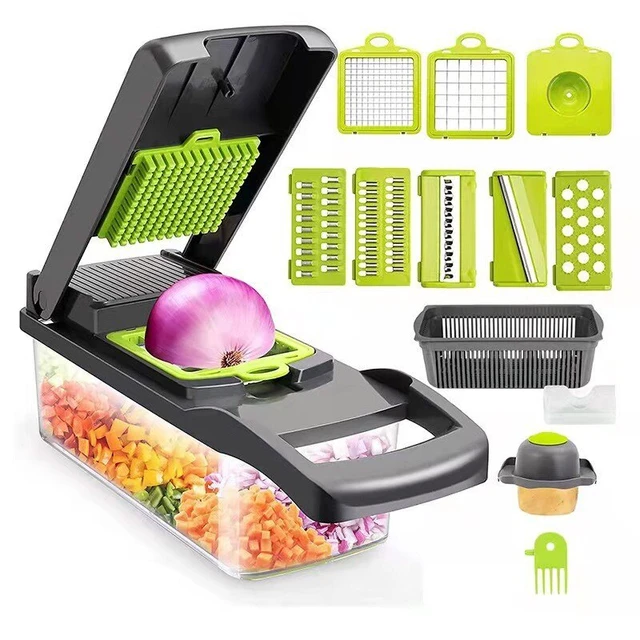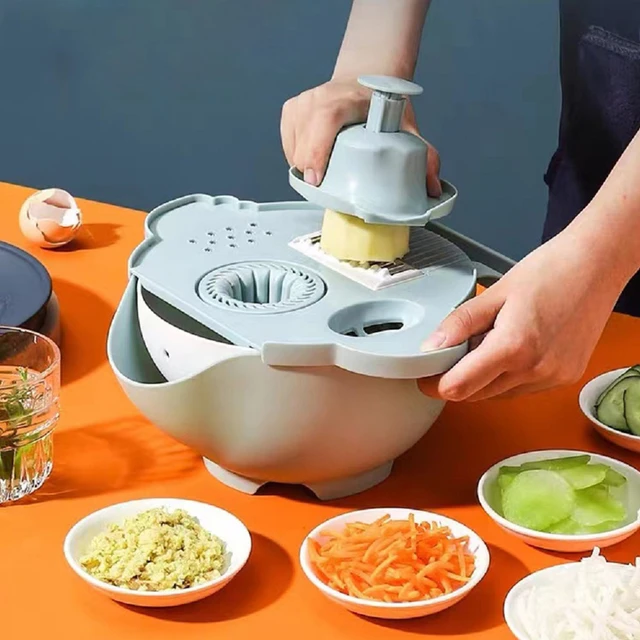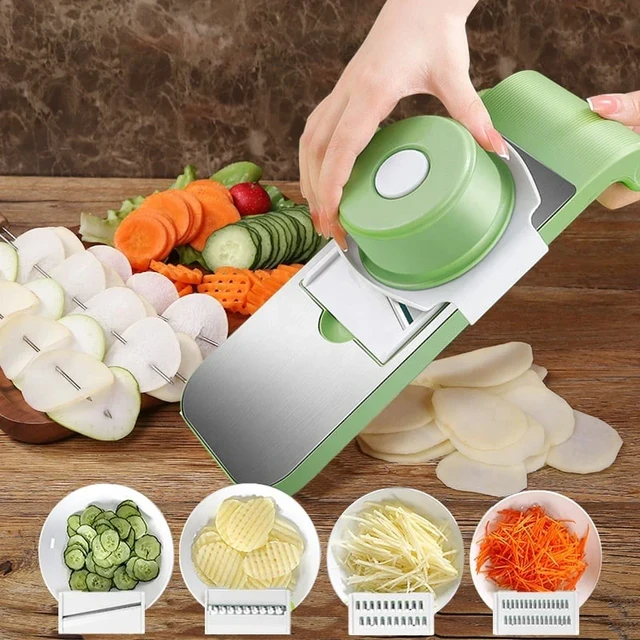 Introduction:
Introduction:
A vegetable slicer, also known as a mandoline slicer or a vegetable cutter, is a versatile kitchen tool that simplifies the process of slicing, dicing, and shredding vegetables. With its sharp blades and adjustable settings, a vegetable slicer can save you time and effort in meal preparation. In this comprehensive guide, we will explore the benefits, types, features, and considerations when choosing a vegetable slicer. By understanding these factors, you can select the best vegetable slicer to suit your needs and elevate your culinary skills.
 Some common types of vegetable slicers:
Some common types of vegetable slicers:
There are various types of vegetable slicers available on the market, each designed for specific slicing techniques and preferences. Here are some common types of vegetable slicers:
Mandoline Slicer:
A mandoline slicer features a flat, angled platform with adjustable blades. It allows you to slice vegetables into uniform thicknesses and create julienne cuts. Mandoline slicers often come with interchangeable blades for different slicing styles.
Spiralizer:
A spiralizer is specifically designed to create thin or thick spiral-shaped cuts or “noodles” from vegetables like zucchini, carrots, or sweet potatoes. It typically includes different blade attachments to achieve various spiralizing results.
V-shaped Slicer:
V-shaped slicers, also known as V-slicers or V-cutters, have a V-shaped blade that cuts vegetables into thin slices. They often come with adjustable thickness settings and are great for cutting paper-thin slices of vegetables or fruits.
Box Grater with Slicer Attachment:
Some box graters come with slicer attachments that allow you to thinly slice vegetables while simultaneously grating cheese or other ingredients. These versatile tools provide multiple functions in one device.
Electric Slicer:
Electric vegetable slicers automate the slicing process and offer convenience. They often come with different blade attachments for various slicing styles and adjustable thickness settings.
Safety Slicers:
Safety slicers are designed to protect your hands during the slicing process. These slicers often feature blade guards and pushers that keep your hands safely away from the blades while slicing vegetables.
Knife-style Slicers:
Knife-style vegetable slicers resemble a knife with serrated or straight blades. They allow you to manually slice vegetables by moving them across the blades, providing control over thickness and shape.
These are just a few examples of vegetable slicers available, each offering different slicing styles and techniques. Consider your specific slicing needs, preferred vegetables, and desired cutting styles when selecting a vegetable slicer that best suits your requirements.
 Benefits of Vegetable Slicers
Benefits of Vegetable Slicers
Time-Saving:
Vegetable slicers significantly reduce the time required for slicing and cutting vegetables compared to manual cutting methods.
They enable swift and consistent cuts, allowing you to prepare ingredients efficiently.
Precision and Uniformity:
Vegetable slicers offer precise and uniform slices, ensuring visually appealing and evenly cooked results.
This is especially useful in dishes that require consistent thickness, such as salads, gratins, or stir-fries.
Versatility:
Vegetable slicers come with interchangeable blades that allow you to create various cuts such as slices, julienne strips, cubes, or grated textures.
This versatility enables you to experiment with different culinary techniques and presentations.
Types of Vegetable Slicers
Manual Vegetable Slicers:
Manual vegetable slicers typically consist of a cutting surface and a handle, requiring physical effort to slice vegetables.
They are compact, easy to use, and ideal for small-scale food preparation.
Handheld Vegetable Slicers:
Handheld vegetable slicers are small and compact tools that allow for quick and easy slicing with handheld motion.
They are convenient for on-the-go or minimal food preparation needs.
Electric or Motorized Vegetable Slicers:
Electric vegetable slicers are motorized devices that automate the slicing process.
They offer more power, speed, and convenience, suitable for larger-scale food preparation or professional kitchens.
 Some common areas where vegetable slicers may be placed:
Some common areas where vegetable slicers may be placed:
Vegetable slicers are typically placed in convenient and accessible locations within the kitchen. Here are some common areas where vegetable slicers may be placed:
Countertop:
Many people prefer to keep their vegetable slicer on the countertop for easy access. This allows for quick and convenient slicing and cutting of vegetables when preparing meals. A dedicated space on the countertop near the food preparation area is ideal.
Kitchen Island:
If you have a kitchen island with ample workspace, it can be an excellent spot to place a vegetable slicer. This provides a separate area for food preparation and keeps the slicer within easy reach.
Pantry or Cabinet:
Some people prefer to store their vegetable slicer in a pantry or kitchen cabinet. This option is useful if you have limited counter space or prefer to keep the slicer out of sight when it’s not in use. It’s important to choose a location that is easily accessible and convenient.
Wall-mounted or Hanging:
Another option is to mount the vegetable slicer onto a wall or hang it on a kitchen utensil rack. This frees up counter space and keeps the slicer within easy reach. Make sure to securely mount or hang the slicer to avoid any accidents or damage.
The placement of a vegetable slicer ultimately depends on personal preference, kitchen layout, and available space. The goal is to have it in a location that is easily accessible, convenient for food preparation, and suits your workflow in the kitchen.
Features and Considerations
Adjustable Blade Settings:
Look for vegetable slicers with adjustable blade settings to achieve different thicknesses and desired cuts.
This feature allows you to customize the slicer to meet your specific culinary requirements.
Safety Features:
Choose vegetable slicers with safety features such as non-slip bases, finger guards, or hand protection aids to prevent accidents or injuries during use.
Ensure that the slicer is stable and secure to maintain control and stability during slicing.
Ease of Cleaning:
Consider vegetable slicers that are easy to disassemble and clean, either by handwashing or dishwasher safe components.
The ease of cleaning ensures hygiene and convenience in maintaining the slicer’s functionality.
Proper Use and Maintenance
Proper Hand Positioning:
Follow the manufacturer’s instructions on hand positioning when using a vegetable slicer to ensure safety and prevent injuries.
Keep fingers and hands away from the blades during operation.
Cleaning and Maintenance:
Clean the vegetable slicer thoroughly after each use, removing any food particles or residue.
Store the slicer in a safe and dry place to maintain its sharpness and prolong its lifespan.
 Conclusion:
Conclusion:
A vegetable slicer is a valuable addition to any kitchen, making vegetable preparation quicker, more efficient, and precise. With various types, features, and considerations available, it is important to choose a vegetable slicer that meets your specific needs and preferences. Whether you opt for a manual, handheld, or electric slicer, ensure it possesses adjustable blade settings, safety features, and ease of cleaning. By using a vegetable slicer correctly and maintaining it properly, you can effortlessly create uniform and visually appealing slices, match your desired cuts, and explore new culinary possibilities. Invest in a vegetable slicer to enhance your cooking experience and elevate your culinary creations.



